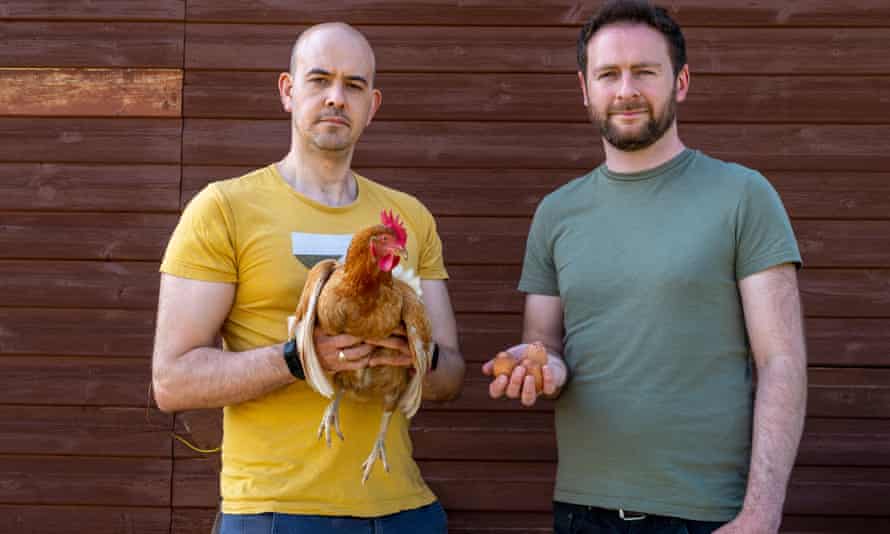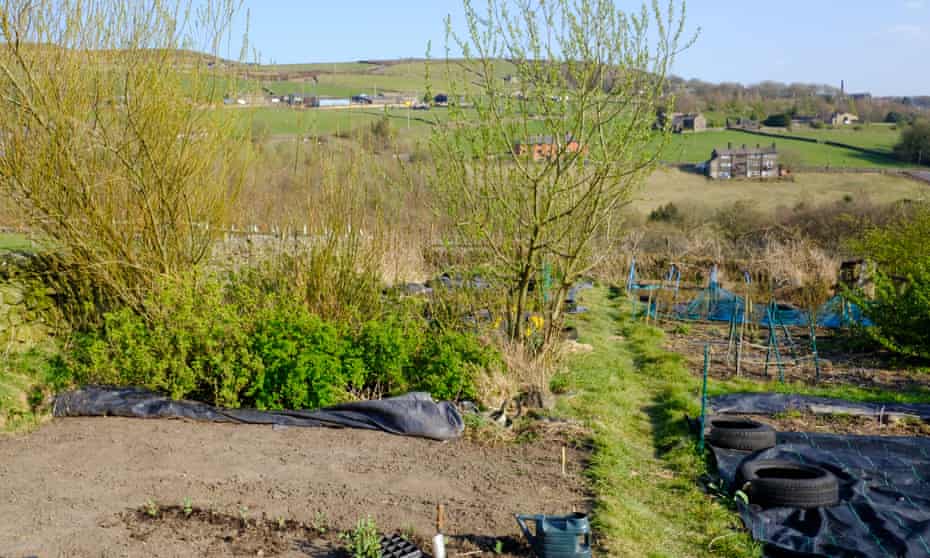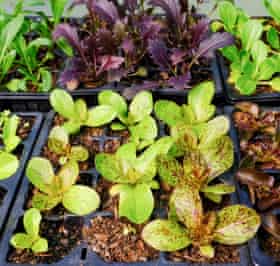In February this year, my partner, Chris, and I left London with a car full of boxes, houseplants and our cat, Rumbles. After 20 years in the capital, we were heading to a new life in Hebden Bridge, West Yorkshire, to grow organic produce and be better connected to nature. Chris grew up in the valley and we felt drawn to the area’s creative scene, rugged landscapes and excellent baked goods.
Also, I am a gardener. The southern British climate is changing, with hotter, drier summers making gardening conditions harder. Dry spells in spring and summer have become longer and more regular. Certain plants, such as dahlias, salad crops and fruit trees that need moisture, are struggling. Summers have become a watering marathon, choosing which plants to save and which to sacrifice. I started switching to drought-tolerant flowers and edibles, such as Hylotelephium, figs and herbs.

Moving to Yorkshire was part of a five-year plan Chris came up with when we were in our mid-30s (he is now 42 and I’m 39). It started to become reality in January 2018 when I gave up my career in online publishing to become a full-time landscape designer. I’d opened my studio part-time a year earlier when friends asked me to help with their gardens.
The pandemic brought our move forward. London lockdowns weren’t all bad, thanks to outside space. Our 40sq metre garden, directly under the Heathrow flight path, turned miraculously quiet save for birdsong. And my allotment, more than seven miles away – where I grew vegetables, fruit, herbs and cut flowers – became my sanctuary. Gruelling 15-mile round trips on a friend’s bike carrying veg and cut flowers along empty roads lined with cow parsley, when the world was falling apart, are my lasting memory.
But I felt I couldn’t garden like this any more; I needed growing space on our doorstep. Our millionth lockdown walk around Clapham Common made us realise that we were living the wrong way around, cut off from the countryside. The sooner we moved to Yorkshire, the better.

Last September, Chris phoned me while on a house-hunting visit to his parents. “I think this is the one,” he said. I jumped on a train the following morning and found myself overwhelmed by the little farm Chris had seen, in our dream location, within walking distance of Hebden Bridge.
It is a 17th-century farmhouse, situated 1,000ft above sea level with views across a woodland canopy and the Calder valley beyond. All our electricity is from renewable sources, including local windfarms, and we’re exploring other sustainable sources, such as geothermal heating, to minimise our carbon footprint.
It has 2.6 hectares (6.5 acres) of land, more than we’d hoped for: 660 times the size of our London garden. It has a patio with a spot for a herb garden by the kitchen door, and a sheltered domestic garden, about 10m x 30m, with a lawn and flower borders where I can experiment with planting. Beyond this lies an informal wildlife garden with a pond and a polytunnel, leading down to a coppice woodland and orchard. It loops back across a wildflower hay meadow to allotments.
The owners, Ben and her partner Sally, had raised their children here, and pioneered a sustainable and wildlife-friendly smallholding, keeping hens and growing blueberries, raspberries and kale. Their wildlife garden contained foxgloves (Digitalis purpurea), primroses (Primula vulgaris) and cow parsley (Anthriscus sylvestris) and, to my delight, a 2-acre hay meadow had yellow rattle (Rhinanthus minor), knapweed (Centaurea nigra) and ox-eye daisy (Leucanthemum vulgare). They had installed solar panels on the farmhouse roof to heat water, and the productive coppice shelters an orchard that slows water runoff to the flood-prone valley below.

We plan to keep the land’s focus on helping wildlife, the climate and growing as many wildflowers as space allows. Insect, bird and mammal populations have declined by as much as 68% in the last few decades, while two in five plants are threatened with extinction due to pesticide use in farming, continuing habitat destruction and climate change.
The coppice and wildflower meadow, around 1.6 hectares (4 acres) of the plot, will coexist for wildlife foremost, while providing wood as well as hay to feed livestock for other local farmers. Everything else is for vegetables, fruit and herbs. I planted potatoes in mid-April, a month later than I would down south, and I’ll scrape earth over the growing shoots until frost-free nights are forecast.
I’ve also planted a large variety of salad crops including lettuce, mibuna, mizuna and mustard in the allotment. I’ve sown hardy broad bean ‘Aquadulce Claudia’, pea ‘Oscar’, chards ‘Pink Flamingo’ and ‘Fordhook Giant’, and root veggies carrot ‘Flyaway’ and parsnip ‘Gladiator’.
Rhubarb grows particularly well in this part of the world and we’re lucky to have an existing unknown variety, plus a generous fruit cage of goodies including blueberries. These need acidic soil and in London that meant growing in ericaceous peat-free compost in pots, but here they flourish – though brassicas such as cabbage and broccoli, which prefer alkaline soils, are a challenge. All fruits will have a generous 5cm layer of well-rotted manure added to the soil around them as an organic fertiliser.
On our window sills, waiting for nights above 5C, are tomato, chilli, aubergine, courgette and squash plants. Directly outside the kitchen, I’ve begun growing a herb garden with the aim of supplying all our herbs: white-flowered rosemary, sage, chives, a number of mints and angelica. From seed I’m growing chamomile, thyme, basil, dill, fennel, cumin and parsley.
We adopted two chickens from Ben and Sally, and plan to rescue a few more former battery hens for free range eggs. Nothing says “farmer” like shepherding our flock of two, who have started laying beautiful speckled eggs.
The challenge of smallholdings with a view is that they are invariably on hillsides, exposed to wind, rain and ice. However, we know this land well, and carefully calculated the exact position we needed to grow: a south-facing slope, which warms up quickly, tucked just low enough into the valley to be shielded from the harshest weather.
Key to exposed gardens is shelter, from dry stone walls, trees, shrubs and hedges. Tough hedges such as Ligustrum ovalifolium (privet), Griselinia littoralis and indigenous Ilex aquifolium (holly) weaken winds to create sheltered microclimates, increasing the range of what you can grow. Deciduous Prunus spinosa (blackthorn) and Sambucus nigra (elder) are great, too – bees love their flowers and birds the berries.

Spring in Yorkshire is a month later than London, autumn a month earlier, and I confess to a sense of relief at this shorter growing season. Summer can be manic in the garden because of watering, weeding and mollycoddling edibles – the most labour-intensive plants – especially alongside my work on other people’s gardens. However, I will extend growing into winter using the polytunnel, hopefully a greenhouse and horticultural fleeces and cold frames.
Polytunnels and greenhouses can be used for growing heat-loving tomatoes, aubergine, peppers and chillies in summer; and, in winter, for protecting hardy salad crops such as lettuce, mizuna and mustards.
Pests are on a different scale from London’s snails and squirrels: deer leap over walls, rabbits hop threateningly closer to our veggies and the fences to keep them out around the perimeters will eventually need replacing. But the extra space makes gardening far easier – a shed for tools, a polytunnel to grow large quantities of seedlings.
Every evening we go for a walk directly from our door, over hills and moors, or into woodland valleys. We have seen a barn owl, bluebells, sunsets and stars. Stars! Hidden from us for two decades by London’s light pollution.
Of course, we miss our friends, Clapham’s community and our little urban garden full of happy memories. We’ve much to learn: Chris needs wellies, and the winters will be harsh. But now we can visit the city from the countryside, rather than the other way around. Life is about balance, and the scales have tipped
Weed If your plot has bare soil, hoe or remove weeds by hand, especially their roots.
Mulch soil Add 3cm of peat-free compost. Well-rotted manure can also be used but must be left for a couple of months; if fresh it can burn roots.

Sow crops in module trays You can sow crops directly in soil in summer but I find it helps to sow many crops in pots or trays of peat-free compost, too. It allows you to protect them from slugs and snails. Sow fast-growing crops such as lettuce, spinach and beetroot in trays with separate cells, and larger pea, bean, courgette and squash plants into individual 9cm pots.
Start composting A compost heap is top priority. Recycle garden waste (one-third green material to two-thirds brown and woody) for next year. Shred large bits of wood.
Create new areas To start a new veg or flower bed, cover an area of lawn or weeds with card and a 5cm layer of compost on top. This will slowly kill the plants beneath by starving them of light. Plant seeds or plugs directly into the compost (immediately is fine); roots will grow through the damp card.
Observe and record In the first year, watch what grows and how the sunlight falls through all seasons before making big changes. Take lots of photos for reference.